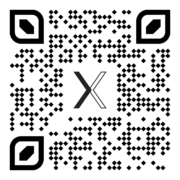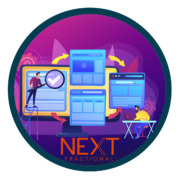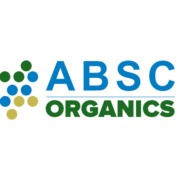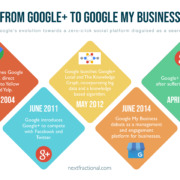Tracking Google’s evolution towards a zero-click social platform disguised as a search platform.
At NEXT, we think it’s important to anticipate the future of digital marketing by understanding and contextualizing the rapid evolution we’ve witnessed in the last few years. Recently, our SEO guru Dwayne Hogan put together a timeline analysis of one of the most important evolutions we’ve seen—Google’s shift from Google+ to Google My Business (GMB). In his timeline, Dwayne makes the case that Google+ was the precursor to Google My Business and that GMB is a social platform disguised as a search platform. Recognizing that Google’s ultimate goal is to create zero-click searches and keep traffic within their own ecosystem enables us to optimize digital marketing strategies for our clients now and position ourselves well for the future. This is important and relevant work, so we wanted to share his insights with all of our NEXT friends and clients.

Google My Business/Local Search Timeline
Google Launches “Google Local”
Date: March 2004
Notes:
The original intent of Google Local was to be a direct competitor to Yellow Pages and Yelp. Primarily a directory of local businesses integrated into Search.

Quotes:
MOUNTAIN VIEW, Calif. March 17, 2004 – Google Inc. today announced the integration of local search results into Google.com with the availability of Google Local. This new feature enables users to find relevant local information with neighborhood business listings, maps, directions, and useful web pages. (source)
Google Launches Google+
Date: June 2011
Notes:
Before Facebook and Twitter, Google was the Internet. When you thought of the Internet, you thought of Google. Thus, Google had all of the attention and traffic.
However, as Facebook and Twitter began to grow, Google recognized that the attention of Internet users began to split between them and social media networks. Also, unlike users of Google Search, when users went to Facebook and Twitter, they stayed on Facebook and Twitter. Social media sites were designed to keep you on the platform as long as possible.
Google+ was the first product built by Google in direct reaction to a competitor and changing consumer habits.
Quotes:
“That March [in 2010], [Google executive] Urs Hölzle sounded an alarm that evoked Bill Gates’s legendary 1995 “Internet Sea Change” missive to his minions at Microsoft. Just as the internet threatened Microsoft back then, in 2010, the sea change to a more people-oriented internet — social media — was becoming a problem for Google. Hölzle said that the challenge required a decisive and substantial response, involving a significant deployment of personnel — right away.” (source)
“In its forays into other areas, like phones, videos, maps, applications, and operating systems, Google had not acted in response to competition. If it had a good idea, it simply pursued it, no matter who was occupying the space. This project was more strategic, even conventional. ‘It’s a good thing that Google is putting its weight behind social networking, but it’s reactive self-interest, not from a place of idealism,’ said one key team member. ‘It’s not Google at its best, which is truly, truly pioneering. Whereas this thing is clearly more of a reaction to Facebook.’” (source)
“[Google search engineer Amit] Singhal spoke passionately about how the internet was increasingly organized around people, urging Google to dramatically expand its focus to create a hub of personalization and social activity. Singhal believed that Facebook not only was ahead in that realm, but, worse, it was building an alternative internet with itself in the center.” (source)
Google Builds the Knowledge Graph
Date: May 2012
Notes:
This is the transformation of Google from a Search Engine to a Knowledge Engine.
Google’s mission is to “organize the world’s information and make it universally accessible and useful.” Before Google+ and the Knowledge Graph, Google primarily focused on organizing web pages. With the Knowledge Graph, Google begins organizing information about people, places, and things, not just web pages.
Now, you can search the word “pizza” on a mobile phone in downtown Salt Lake City and receive a list of the best pizza restaurants nearby. Before the Knowledge Graph, you may receive a list of pizza restaurants or a recipe for pizza.
Quotes:
“Take a query like [taj mahal]. For more than four decades, search has essentially been about matching keywords to queries. To a search engine the words [taj mahal] have been just that—two words. But we all know that [taj mahal] has a much richer meaning. You might think of one of the world’s most beautiful monuments, or a Grammy Award-winning musician, or possibly even a casino in Atlantic City, NJ. Or, depending on when you last ate, the nearest Indian restaurant. It’s why we’ve been working on an intelligent model—in geek-speak, a “graph”—that understands real-world entities and their relationships to one another: things, not strings.” (source)
“The Knowledge Graph enables you to search for things, people or places that Google knows about—landmarks, celebrities, cities, sports teams, buildings, geographical features, movies, celestial objects, works of art and more—and instantly get information that’s relevant to your query. This is a critical first step towards building the next generation of search, which taps into the collective intelligence of the web and understands the world a bit more like people do.” (source)
“Google told us that the new local search algorithm [Pigeon] ties deeper into their web search capabilities, including the hundreds of ranking signals they use in web search along with search features such as Knowledge Graph, spelling correction, synonyms and more.” (source)
Google Launches Google My Business
Date: June 2014
Notes:
Google continues to invest in local search with Google My Business (GMB). Instead of businesses having to manage their search presence on multiple platforms, GMB brings their search management to one hub.
Along with being a management platform for companies, it also is an engagement platform that allows owners to share news and events, post photos, and interact with customers.
Quotes:
“Google My Business brings together all the ways Google can help your business shine in one place:
- Update your business info on Search, Maps and Google+ from one place to make it easy for customers to get in touch
- Add beautiful photos of your business and a virtual tour of your business interior to help customers see what makes your business unique
- Connect directly with your fans and customers by sharing news, events and other important updates from your Google+ page
- Stay on top of reviews from across the web, and respond to Google reviews
- Understand how people find and interact with your business using custom insights and integration with AdWords Express
The Evolution of Social Networks
Date: 2015-2018
Notes:
Google+ was the wild west, allowing all content to be viewed equally. A spam post could get the same visibility as an engaging video from a non-profit.
Early versions of Facebook and Twitter had the same problem. However, both social networks adjusted their algorithms to provide users with more relevant content. Google+ never adjusted and engagement suffered.
Sites like Facebook, Twitter, and Google+ thrive on engagement. No engagement = no ad revenue.
Today, everyone focuses on responding to reviews in GMB. It’s the clearest path to engagement. But, metrics inside of the Insights dashboard show that Google also cares about KPIs like photo and post views, actions, etc.
Quotes:
“For more than a year now since [Twitter] enhanced our timeline to show the best Tweets for you first, we have worked to improve the underlying algorithms in order to surface content that is even more relevant to you.” (source)
“In mid-2015, Facebook introduced a major algorithm change that pivoted readers away from journalism and news, to deliver more updates from their friends and family. The change was couched in friendly language suggesting Facebook was trying to make sure users didn’t miss stories from friends.” (source)
Google+ Shuts Down
Date: April 2019
Notes:
Google+ shuts down in April 2019. Google+ suffered from a data leak and, instead of fixing the leak, Google shut down the product.
Other social media networks like Facebook have experienced data leaks. However, Facebook’s user engagement made it worth fixing and continuing the service. The user engagement on Google+ was so low (less than 5 seconds a session) that they felt it wasn’t worth saving.
However, Google’s social efforts didn’t completely die with Google+. It’s at this point that we see features and principles implemented on Google+ begin to migrate to Google My Business.
Quotes:
“The consumer version of Google+ currently has low usage and engagement: 90 percent of Google+ user sessions are less than five seconds.” (source)
“A study from Stone Temple Consulting revealed that 90% of people registered on Google+ had never posted anything on the platform.” (source)
“So the light goes out on Google+, in my opinion, Google is preparing other features to overcome this, especially for businesses. Local SEO is becoming a major challenge for businesses, Google My Business takes a dimension a little more specific. It is a very effective tool for local SEO that allows real optimization of timing, especially for data management. In short, we can say that Google My Business is a must for local SEO for organizations and companies.” (source)
Google Stays Social
Date: 2019-2021
Notes:
Google My Business continues to look more and more like a social network. Not a typical people-centered network, but a network between people and local businesses.
Google My Business is Social, disguised as Search. Google recognizes that people want to be more connected to the business they love. They also recognize that social proof is a powerful motivator for consumers. The features added to Google My Business during this time help accomplish these two goals.
Google appears to be rewarding users who take advantage of these social features. For example, a recent study shows a massive correlation between profiles that have at least 100 images and increases in profile view and action metrics.
Features designed to add a social feel to GMB:
- Adding feeds for local business updates to Google Maps
- We actually see this “feed” strategy implemented across multiple products. For example, Google Pay has a feed similar to the feed in Venmo, where you can connect directly with the people and business whom you have sent money to.
- Also, the Discover tab in the Google app could be considered the feed for Search, taking your recent search history and presenting you with additional content based on your history.
- Posts and Q&A to Google My Business,
- Messaging in Google My Business
- An increasing number of “attributes” that can be used by owners to describe their businesses. For example, a business can label themselves “LGBTQ+ friendly”
- Google+ was designed around passions, and people could discover and connect with others who had similar passions. Attributes in Google My Business work in a similar way, where people can connect with businesses that are, for example, LGBTQ+ friendly, veteran or women-led, handicap accessible, etc.
Quotes:
“Well, Google+ itself may have failed, but Google is slowly and subtly rebuilding it, in a sense, right before our eyes. You just have to zoom out a little to see the forest for the trees and put the pieces together.” (source)
“Google officially pulled the plug on its high-profile Google+ service in the spring of 2019, as you may recall — though, interestingly enough, it actually announced the timing of that shutdown exactly two years ago today. At the time, it seemed like the end of Google’s social ambitions. But it’s becoming increasingly clear that wasn’t entirely right.” (source)
“But fast-forward to today, and what do we see once more? Yep, you guessed it: Google building systems designed to encourage you to stick within its own ecosystem when you want to share something instead of instinctively hopping over to a more traditional social service.” (source)
“The feed shows you the latest reviews, photos, and posts added to Google Maps by local experts and people you follow as well as food and drink merchants, and articles from publishers. … [It] brings together helpful local information and tailors it to your selected interests.” (source)
“Facebook is like a very big party, where you know everyone already. But Google+ is a smaller, more intimate party filled with people you don’t know yet — but who have interesting things to say on a variety of topics. If Facebook is for friends and family, Twitter is for sharing thoughts and opinions and LinkedIn is for self-promotion — then Google+ is for talking about things you’re most passionate about with new and exciting people.” (source)
“There’s little that compares to the feeling of walking into a place and being immediately comfortable—your shoulders loosen, your breathing slows, you physically relax, knowing you can be yourself. Finding those spaces has often been hard for the LGBTQ+ community. We want to help celebrate those spaces of belonging and make them easier to find.” (source)
“Businesses with more than 100 images get 520% more calls than the average business, while those with just one image get 71% fewer.
- Businesses with more than 100 images get 2,717% more direction requests than the average business, while those with just one get 75% fewer.
- Businesses with more than 100 images get 1,065% more website clicks than the average business, while those with just one get 65% fewer” (source)
What Does This All Mean?
Date: 2021-
Notes:
Google’s push to make Google My Business more social is part of a larger strategy to create zero-click searches, where a user’s questions are answered without going to a website. This zero-click search strategy increases engagement on Google products, which increases their ad revenue.
Examples of this include:
- Featured Snippets and People Also Ask boxes
- Hotel and Flight reservation ads
- AMP
- The click goes to the AMP URL managed by Google, not to the actual website
- The “Discover” tab in the Google App
- Click to call and direction actions within local search
- Car dealership inventories on GMB listings
56% of actions on GMB listings are visits to the website. This lines up with Rand Fishkin’s data that 50% of searches are zero-click searches.
As a general strategy, businesses should use Google My Business as if the website doesn’t exist. They should ask themselves, “Assuming that GMB is the only marketing channel available, what would you do?”
Quotes:
“On average, 56% of actions on GMB listings are website visits” (source)
“Last year, as part of our continued efforts to help connect businesses with potential customers, we began working with select car dealers and data providers in the U.S. to pilot new ways for dealerships to showcase their cars for sale directly on their Business Profiles in Search. We’ve heard from potential car buyers that surfacing this inventory information directly on Google helps them quickly explore and compare available cars, leading to more qualified leads for dealers. Dealers and related businesses can fill out a partner interest form if they’d like to learn more about this opportunity. The car inventory information is powered by feeds shared directly from dealers or their data providers. Google is not charging a fee for this feature.” (source)
Wrapping It All Up
Recognizing the import of Google’s moves and understanding the implications of their zero-click model is critical to a successful digital strategy. Winning the SEO game means adapting along with the industry behemoth and embracing Google My Business as a key component of your digital marketing arsenal. We believe GMB will continue to be an ever larger driver of digital engagement in the future, and nobody can afford to ignore it.
 Building a tool that allows customers to self-steer and purchase services online brings big revenue gains for NEXT partners
Building a tool that allows customers to self-steer and purchase services online brings big revenue gains for NEXT partners 






 Implementing a Microsite Retail Strategy For a Telecommunications Giant Delivers Major Impact
Implementing a Microsite Retail Strategy For a Telecommunications Giant Delivers Major Impact


 ABSC Organics Finds eCommerce Success with NEXT Fractional
ABSC Organics Finds eCommerce Success with NEXT Fractional


